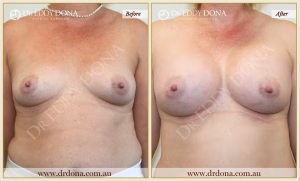Double Bubble – a customised video animation explaining what double bubble means and four different causes?
Double bubble is a problem that can develop after breast augmentation. There are a number of possible causes of the double bubble, but the key sign of it is a groove along the lower breast curve creating the appearance of a bubble sitting on top of another bubble, hence the term double bubble.
One example of double bubble is that which can occur in a woman that has a very short distance from the nipple to the lower breast fold, or a tight breast base. In this example, an excision is typically placed below the breast fold. The lower end of the muscle is identified and detached from the chest all, and a space is made under the muscle to accommodate the implant. The implant is then inserted and positioned and the wound closed. In this situation, the implant position is below the original breast fold which is now sitting along the lower breast curve. Initially this region remains tight and causes a flatness or indentation. This indentation is what creates the double bubble. Over time as the breast tissue softens and the implant settles, this double bubble typically resolves, resulting in a smooth lower breast curve. However, sometimes due to a natural persistent tightness at the site of the original breast fold, this double bubble persists. To compound the problem, at the level of the original breast fold where the muscle sits close to the skin, as this muscle contracts it pulls in the skin causing a dynamic double bubble.
A double bubble can also occur in those who have a loose and well-formed lower breast curve with a long distance from the nipple to the lower breast fold. Here it can occur if the incision is placed too low, below the breast fold, and the implant is therefore effectively placed too low. In this situation, the lower end of the muscle is detached from the chest wall and the implant pocket is made deep to the muscle. The implant is then inserted and positioned and the wound closed. However, here we have the breast implant sitting too low, below the natural breast tissue mound, and the original breast fold remains tight. The end result is an implant sitting below the original breast mound with the breast tissue sitting on top of the implant mound, and with the persistent tightness of the original breast fold, this creates an appearance of a breast tissue hanging from an implant mound, creating a significant double bubble.
Another cause of double bubble is caused when a correctly placed implant drops down below where it was originally placed, otherwise known as bottoming out. In this type, if the lower breast fold remains tight, then as the implant bottoms out it ends up with a situation with the implant sitting too low and the breast tissue mound hanging from it.
The final cause of a double bubble occurs due to changes that can develop to the natural breast tissue over time. In this example we have a normal ample-breasted woman with implants sitting in the correct position and a nice lower breast curve. Over time, normal changes in natural breast tissue volume associated with natural body weight fluctuations can change the appearance of the breasts. However, if the natural breast tissue softens up and drops down, a common occurrence with weight loss or after pregnancy and breastfeeding, then the breast tissue drops down and effectively starts to hang from the breast implant mound. This can result in a significant double bubble formation.








